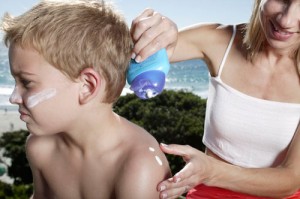ENVIRONMENT: Sunscreens cause skin cancer?
ENVIRONMENT: Sunscreens cause skin cancer?

Most of us assume that all we need do to prevent sunburns and skin cancer from exposure to the sun is to slather on sunscreen. But consumers should be careful about which sunscreens they trust for themselves and, even more important, for their kids. PHOTO: Fuse/Thinkstock
Dear EarthTalk: I imagine you’ve been down this road before, but what’s hot in the green-friendly sunscreen department nowadays? –Elaine Mayer, Ocean City, MD
Most of us assume that all we need do to prevent sunburns and skin cancer from exposure to the sun is to slather on any of the widely available sunscreens on the market today. But the non-profit Environmental Working Group (EWG) points out that this may not be the case, and that consumers should be careful about which sunscreens they trust for themselves and, even more important, for their kids.
According to EWG, some researchers have detected an increased risk of melanoma skin cancer among sunscreen users. “No one knows the cause, but scientists speculate that sunscreen users stay out in the sun longer and absorb more radiation overall,” reports EWG. Scientists also suspect, says EWG, that free radicals, which get released as sunscreen chemicals break down in sunlight, may be playing a role.
Most sunscreens screen out some of the ultraviolet B (UVB) rays from the sun that lead to visible sun burns, but many do not protect against the potentially more damaging ultraviolet A (UVA) rays that penetrate deeper into the skin and may facilitate the development of skin cancer later on, regardless of how high a Sunburn Protection Factor (SPF) the sunscreen may have. Also, EWG warns that many common sunscreen ingredients generate free radicals that can damage the body’s DNA and skin cells, accelerating skin aging and potentially causing skin cancer in the process.
But just because some sunscreens can’t be trusted and overexposure to the sun is unhealthy doesn’t mean staying indoors all the time is a viable solution. Getting some sun is good for you, as the body converts it to Vitamin D, an essential nutrient that facilitates good health and prevents a wide range of diseases.
So what’s a sun lover to do? The International Agency for Research on Cancer (IARC) recommends wearing protective clothing, seeking shade, and timing outdoor play to avoid peak sun. IARC adds that sunscreen still has a place in our lives to augment these other sun exposure minimization tactics.
But which sunscreens do live up to EWG’s stringent standards? The major choice is between chemical sunscreens that break down quickly, penetrate deep into the skin and may disrupt the body’s hormone system, and mineral varieties that can contain potentially irritating and damaging nano-scale particles.
According to EWG, mineral sunscreens are the better choice, as they protect against both UVB and UVA rays, remain effective longer and don’t contain as many dangerous substances. Some leading mineral-based options come from Alba Botanica, Beyond Coastal, ECO Logical Skin Care, Karen’s Botanicals, Kiss My Face, Poofy Organics and Solar Sense, among others.
For those who don’t like mineral based sunscreens, which can be chalky and leave a white film until washed off, EWG recommends sunscreens with avobenzone (three percent for the best UVA protection) and without the notorious hormone disrupter oxybenzone. Some leading non-mineral choices are available from manufacturers including Bull Frog, Ocean Potion, Sunbow and Vichy.
CONTACTS: EWG’s Sunscreens 2012, breakingnews.ewg.org/2012sunscreen/; IARC, www.iarc.fr.
EarthTalk® is written and edited by Roddy Scheer and Doug Moss and is a registered trademark of E – The Environmental Magazine ( www.emagazine.com). Send questions to: earthtalk@emagazine.com. Subscribe: www.emagazine.com/subscribe. Free Trial Issue: www.emagazine.com/trial.
Comments (0)